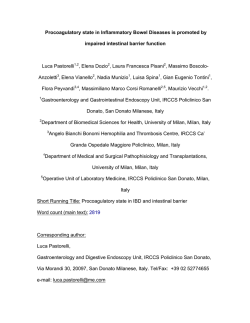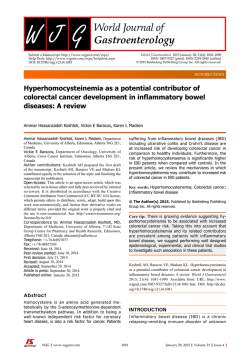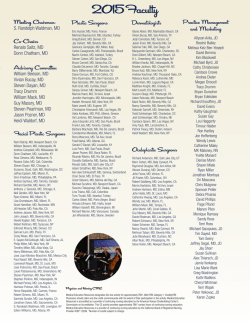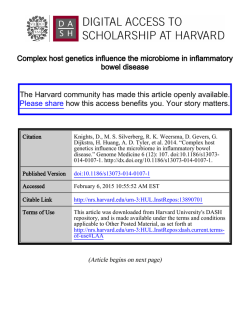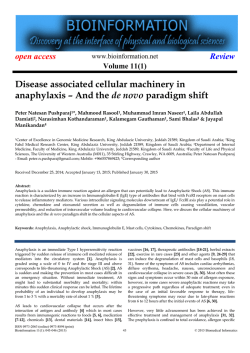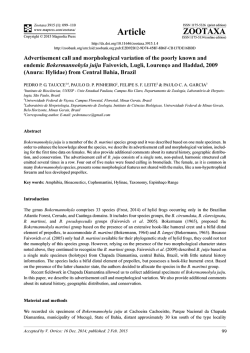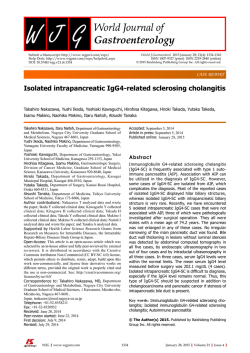
PDF (1178K) - World Journal of Gastroenterology
World J Gastroenterol 2015 January 28; 21(4): 1197-1206 ISSN 1007-9327 (print) ISSN 2219-2840 (online) Submit a Manuscript: http://www.wjgnet.com/esps/ Help Desk: http://www.wjgnet.com/esps/helpdesk.aspx DOI: 10.3748/wjg.v21.i4.1197 © 2015 Baishideng Publishing Group Inc. All rights reserved. ORIGINAL ARTICLE Retrospective Study Inflammatory bowel disease in an underdeveloped region of Northeastern Brazil José Miguel Luz Parente, Claudio Saddy Rodrigues Coy, Viriato Campelo, Mírian Perpétua Palha Dias Parente, Leonardo Araújo Costa, Renata Mendes da Silva, Celso Stephan, José Murilo Robilotta Zeitune José Miguel Luz Parente, Viriato Campelo, Center for Health Sciences, Federal University of Piaui (Universidade Federal do Piauí - UFPI), Teresina, Piauí 64049-550, Brazil Claudio Saddy Rodrigues Coy, Department of Surgery, School of Medical Sciences, State University of Campinas (Universidade Estadual de Campinas), Campinas, São Paulo 13083-970, Brazil Mírian Perpétua Palha Dias Parente, Center of Health Sciences, State University of Piaui (Universidade Estadual do Piauí - UESPI), Teresina, Piauí 64001-280, Brazil Leonardo Araújo Costa, Renata Mendes da Silva, Federal University of Piaui (Universidade Federal do Piauí - UFPI), Teresina, Piauí 64049-550, Brazil Celso Stephan, Department of Public Health, School of Medical Sciences, State University of Campinas (Universidade Estadual de Campinas - Unicamp), Campinas, São Paulo 13083-970, Brazil José Murilo Robilotta Zeitune, Department of Internal Medicine, School of Medical Sciences, State University of Campinas (Universidade Estadual de Campinas - Unicamp), Campinas, São Paulo 13083-970, Brazil Author contributions: Parente JML, Coy CSR, Campelo V, Parente MPPD and Zeitune JMR designed the research and contributed equally to this work; Costa LA and da Silva RM collected the data; Stephan C analyzed the data; Parente JML wrote the paper. Open-Access: This article is an open-access article which was selected by an in-house editor and fully peer-reviewed by external reviewers. It is distributed in accordance with the Creative Commons Attribution Non Commercial (CC BY-NC 4.0) license, which permits others to distribute, remix, adapt, build upon this work non-commercially, and license their derivative works on different terms, provided the original work is properly cited and the use is non-commercial. See: http://creativecommons.org/ licenses/by-nc/4.0/ Correspondence to: José Miguel Luz Parente, MD, PhD, Professor of Gastroenterology, Center for Health Sciences, Federal University of Piaui (Universidade Federal do Piauí UFPI), Teresina, Piauí 64049-550, Brazil. [email protected] Telephone: +55-86-99813603 Fax: +55-86-32372060 Received: April 3, 2014 Peer-review started: April 4, 2014 First decision: May 13, 2014 WJG|www.wjgnet.com Revised: July 9, 2014 Accepted: August 13, 2014 Article in press: August 28, 2014 Published online: January 28, 2015 Abstract AIM: To evaluate the demographic characteristics and clinical phenotypes of inflammatory bowel disease (IBD) in a geographic area in Northeastern Brazil. METHODS: This retrospective study was conducted at the Hospital of the Federal University of Piauí in Northeastern Brazil. Demographic characteristics and clinical phenotypes of IBD were analyzed in relation to the time of diagnostic confirmation, which was defined as the date of disease onset. Data were collected between January 2011 and December 2012 and included all census patients 18 years of age or older during that period for whom there was diagnos tic confirmation of Crohn’s disease (CD), ulcerative colitis (UC), or unclassified colitis according to the Montreal criteria. We also analyzed the period of time between the onset of clinical manifestations and the diagnosis of IBD (delay in the diagnosis). Statistical analyses included means and standard deviations for 2 numeric variables and the Pearson χ adherence test for nominal variables. The annual index occurrence and overall prevalence of IBD at our institution were also calculated, with P values < 0.05 indicating statistical significance. This study was approved by the Institutional Ethics and Research Committee. RESULTS: A total of 252 patients with IBD were included, including 152 (60.3%) UC patients and 100 (39.7%) CD patients. The clinical and demographic characteristics of all patients with IBD showed a female to male ratio of 1.3:1.0 and a mean age of 1197 January 28, 2015|Volume 21|Issue 4| Parente JML et al . Inflammatory bowel disease in Northeastern Brazil [1] 35.2 (SD = 14.5) years. In addition, the majority of patients were miscegenated (171, 67.9%), had received higher education (157, 62.4%), lived in urban areas (217, 86.1%), and were under the age of 40 years (97, 62.5%). For patients with CD, according to the Montreal classification, the predominant features present from the onset of disease were an age between 17 and 40 years (A2); colonic disease location (L2); and nonstricturing, nonfistulizing disease behavior (B1). However, approximately one-quarter of all CD patients demonstrated perineal involvement. We also observed considerable delay in the diagnosis of IBD throughout the entire study period (mean = 35.5 mo). In addition, the annual index occurrence rose from 0.08 to 1.53 5 cases/10 inhabitants/year during the study period, and 5 the prevalence rate was 12.8 cases/10 inhabitants in 2012. Over the last two decades, there was a noted increase in the frequency of IBD in the study area. and ulcerative colitis (UC), have been highlighted . CD is characterized by discontinuous and transmural inflammation that can involve any segment of the GIT, sometimes presenting stenotic or penetrating behavior with the formation of abscesses and [2] fistulas . UC is an inflammatory process confined to the mucosa and submucosa of the large intestine, with a characteristic gradient of greater to minor [3,4] severity in the distal to proximal direction . Un classified colitis is defined when the disease involves only the large intestine and presents superimposed clinical and endoscopic characteristics of both CD [5,6] and UC . The incidence and prevalence of IBD are higher in countries with greater economic development, especially in the northern countries of Western Europe, Canada, the United States of America, Australia, [7,8] and New Zealand . In recent decades, there has also been an increase in these rates in countries of Southern and Eastern Europe and, to a lesser extent, the Middle East, North Africa, and some [9-11] Asian countries . In Latin America, there are few epidemiological studies of IBD, although some studies have reported growth in the frequencies of both CD and UC in this region, despite the low incidence of [12,13] these diseases . In Brazil, epidemiological studies of IBD are also very scarce, although increased frequencies of outpatient visits and hospitalizations in the major urban [14-16] centers of Brazil have been observed . However, no studies have been conducted with large Brazilian territorial coverage regarding the demographic and clinical aspects of IBD. The purpose of this study was to address the lack of data on IBD in the state of Piauí, an area in the Brazilian Northeast, where living conditions are considered the worst (Figure 1). In recent decades, Brazil has experienced a continuous increase in the Human Development Index (HDI) from 0.590 in 1990 to 0.718 in 2010, although the country still th stands at 84 in United Nations rankings. In Piauí, the HDI was reportedly lower (0.646 in 2010) than the HDI of southern and southeastern Brazilian states (HDIs between 0.731 and 0.783) and the [17] federal capital (an HDI of 0.824) . The main objective of this study was to identify the demographic characteristics and clinical phenotypes of IBD in a geographic area in Northeastern Brazil with a low HDI. In addition, we sought to calculate the annual index rate for the occurrence and pre valence of IBD at our institution. CONCLUSION: In this study, there was a predominance of patients with UC, young people under 40 years of age, individuals with racial miscegenation, and low annual incomes. Key words: Inflammatory bowel diseases; Crohn’s disease; Ulcerative colitis; Epidemiology; Human Development Index © The Author(s) 2015. Published by Baishideng Publishing Group Inc. All rights reserved. Core tip: This study addressed the demographic characteristics and clinical phenotypes of inflammatory bowel disease (IBD) patients in Northeastern Brazilian, where living conditions are poor and there is a lack of data on this subject. Over the last two decades, there was a noted increase in the frequency of IBD in the study area, although there was considerable delay in disease diagnosis throughout the study period. There was a predominance of patients with ulcerative colitis, but there was no difference between males and females in terms of disease frequency. Most individuals were aged below 40 years, had miscegenated ethnic characteristics, and received low annual incomes. Parente JML, Coy CSR, Campelo V, Parente MPPD, Costa LA, da Silva RM, Stephan C, Zeitune JMR. Inflammatory bowel disease in an underdeveloped region of Northeastern Brazil. World J Gastroenterol 2015; 21(4): 1197-1206 Available from: URL: http://www.wjgnet.com/1007-9327/full/v21/i4/1197.htm DOI: http://dx.doi.org/10.3748/wjg.v21.i4.1197 INTRODUCTION MATERIALS AND METHODS Inflammatory bowel disease (IBD) encompasses a group of chronic and idiopathic inflammatory di seases preferentially affecting the gastrointestinal tract (GIT). Two subcategories, Crohn’s disease (CD) Study location WJG|www.wjgnet.com The study was conducted at the Hospital of the Federal University of Piauí (HU-UFPI), which is considered a reference center for the treatment of 1198 January 28, 2015|Volume 21|Issue 4| Parente JML et al . Inflammatory bowel disease in Northeastern Brazil Study design N W The study was designed to describe the demographic and clinical characteristics of patients with IBD at the time of diagnostic confirmation, which was defined as the date of disease onset. This retrospective study involved a cohort of patients who were in clinical follow-up at HU-UFPI. The subjects’ demographic and clinical data were collected directly from the medical records of the Digestive System Unit of HUUFPI and were supplemented with patient interviews during periodic outpatient clinical reviews. The data were collected between January 2011 and December 2012 and included all census pa tients 18 years of age or over for whom there was diagnostic confirmation of CD, UC, or unclassified colitis. Individuals who received disease diagnoses during childhood or adolescence but who were at least 18 years of age at the time of data collection were also included. The dependent variables included diagnosis (CD or UC), classification of CD and UC according to the [6] Montreal criteria , and the period of time between the onset of clinical manifestations and the diagnosis of IBD. The independent demographic variables included age, gender, race, education, family income, and residence in an urban or rural area. The inde pendent clinical variable was a family history of IBD. Patients who were diagnosed with unclassified colitis at the onset of the disease were included in the CD or UC groups, considering the subsequent diagnostic definition established during clinical follow-up of these individuals. E S The equator Piaui Brazil South America Figure 1 Study area (Piauí State), located in the tropical zone in the northeastern region of Brazil. patients with IBD. The strategic location of this hospital in the capital of Piauí, Teresina, and its inclusion in a computerized public health network result in the referral of patients from all other hospitals and public health centers throughout the state. In the state of Piauí, approximately 85% of the population receives health care solely through the public system, and our institution has been the only public hospital in the state to care for patients above 15 years of age with IBD. Statistical analysis To perform statistical analyses, we first created a database using Microsoft Excel, the results of which are presented in tables and graphs. The following analyses were used: means and standard deviations 2 for numeric variables and the Pearson χ adherence test for nominal variables (gender, race, education, and income). These variables were compared with the respective census data for the population of the state of Piauí. The significance level used for all tests was 5%. We also calculated the annual index occurrence and the prevalence rate of IBD in our hospital based on the annual frequency of IBD and annual population data from the state of Piaui (85% of people over 15 years of age, as explained in the “study location” section) for the period from 1988 to 2012, according to census data from the Brazilian government (Instituto Brasileiro de Geografia e Es [18] tatística) . Diagnosis of IBD The diagnosis of IBD was established according [1] to previously developed criteria for CD and UC , including clinical, ileocolonoscopic, laboratory, and histopathological aspects as well as computed tomography (CT) or magnetic resonance imaging enterography studies of the small intestine. When necessary, we performed endoscopic examinations of the upper GIT to evaluate the esophagus, stomach, and duodenum. All patients underwent investigation for gastroenteritis (coproculture) and intestinal parasites (stool test). In view of the high prevalence of enteroparasitoses in the study region, all patients received antiparasitic treatment with albendazole, secnidazole, and ivermectin regardless of the outcome of the stool examinations. The differential diagnosis of intestinal tuberculosis was based on clinical data, chest radiography, Mantoux intradermal testing, and the histological results of biopsy specimens. Mansonic schistosomiasis is endemic in many areas of Northeastern Brazilian, although there were no outbreaks in the region covered by this study. WJG|www.wjgnet.com Ethical considerations This study was approved by the Research Ethics Committee of our institution (CAAE: 0140.0.045.000-11), and ethical principles for medical research involving 1199 January 28, 2015|Volume 21|Issue 4| Parente JML et al . Inflammatory bowel disease in Northeastern Brazil human subjects were observed during all stages, including ensuring the anonymity of patients. All par ticipants were adequately informed about the study and signed an informed consent form authorizing their inclusion in the study. cases of IBD (CD = 12, UC = 13) in 2012. In this context, given both the natural population growth of the state of Piauí and the gross annual rate of new cases identified in this study, the annual index occurrence of IBD at our institution was 5 0.08 cases/10 inhabitants/year in 1988, and this 5 rate reached its peak in 2007 with 1.53 cases/10 inhabitants/year (Figure 3). In 2012, the prevalence 5 of IBD at our institution was 12.8 cases/10 inha bitants. Throughout the study period, there was consi derable delay in the diagnosis of IBD. In particular, the mean time (in mo) between the onset of clinical manifestations and the diagnosis of IBD throughout the entire study period was 35.5 mo. Regarding the etiopathogenesis of IBD, we ana lyzed two aspects: a family history of UC or CD and tobacco use. There was a history of IBD among firstand second-degree relatives in 29/252 (11.5%) cases, including 16/100 (16.0%) CD patients and 13/152 (8.6%) UC patients. A personal history of previous or current smoking was noted in 53/252 (21.0%) of all patients with IBD, including 21/100 (21.0%) with CD and 32/152 (21.1%) with UC. RESULTS DISCUSSION The confirmation of IBD diagnosis for all patients included in this study occurred between 1988 and 2012. Two hundred fifty-two consecutive patients treated in the IBD outpatient unit were included, of which 152 (60.3%) had UC and 100 (39.7%) had CD. The age at disease onset ranged from 12 years to 82 years, with a mean of 35.2 (SD = 14.5) years. The mean ages for the onset of CD and UC were 32.9 (SD = 13.6) years and 36.8 (SD = 14.8) years, respectively. Figure 2 shows the frequency distribution of the ages of patients with CD and UC at the time of diagnosis. Regarding gender, there was a male to female ratio of 1.2 to 1.0 in the group of patients with CD, but there was no significant association with gender upon statistical analysis (P = 0.32). Patients with UC were predominantly female, with a female to male ratio of 1.8 to 1.0; this association was statistically significant (P = 0.005). Table 1 shows the demographic aspects of the study subjects and the population characteristics of the state of Piauí for comparison and statistical analysis. The [6] patients' clinical features according to the Montreal classification are shown in Table 2 for CD and Table 3 for UC. The annual rate of new IBD cases increased slowly between 1988 and 1998, corresponding to a rate of one to five new patients per year in that decade. In the last years of the twentieth century and the first decade of this century, significant increases in the gross annual frequencies of these diseases were observed, reaching a rate of 25 new Historical data for overall IBD geographic distribution worldwide have consistently shown higher rates of incidence and prevalence in more developed countries, the populations of which are predominantly [12] Caucasian . More recently, IBD has been detected with increasing frequency across all continents, including less developed countries, affecting people [9,10,19] with different ethnic characteristics . This study was conducted in a Brazilian region with the lowest socioeconomic human development indicators. In line with the low HDI, the average income per capita of the population of the state of Piauí (2965.00 USD per year) is well below the average per capita income of Brazil (4602.12 USD per year), while the average family income of participating patients in this research was higher [18] [7084.80 (SD = 531.50) USD] . In this Brazilian region with poor living conditions, IBD is still a rare clinical condition compared to countries with high HDIs, where incidence rates are historically 5 much higher, usually from 10.0 to 20.0 cases/10 inhabitants/year as well as higher than 20.0 5 [8] cases/10 inhabitants/year . However, in the 25 years of this study, we found that there was a gradual increase in the annual index occurrence at 5 our hospital, reaching 1.53 cases/10 inhabitants/ year and culminating in an intermediate pre 5 valence rate corresponding to 12.8 cases/10 inhabitants in 2012. Our results were still much lower compared to those reported by Victoria et [15] al for the period of 1986 to 2005 in a more industrialized area of Southeastern Brazil, where 50 UC 45 CD 40 Frequency (n ) 35 30 25 20 15 10 5 0 < 20 20-30 31-40 41-50 Age (yr) 51-60 61-70 > 70 Figure 2 Distribution of patients with ulcerative colitis and Crohn’s disease according to age group in Piauí State (Brazil), 1988-2012. UC: Ulcerative colitis; CD: Crohn’s disease. WJG|www.wjgnet.com 1200 January 28, 2015|Volume 21|Issue 4| Parente JML et al . Inflammatory bowel disease in Northeastern Brazil Table 1 Demographic characteristics of the population of the state of Piauí (Brazil) in 2010 and of patients with inflammatory bowel disease (total), Crohn’s disease, and ulcerative colitis according to gender, race, education, family income, and residence (urban or rural) in Piauí (Brazil), 1988-2012 Demographic variables General population of 1 Piauí : (n = 3118360) Gender Race Education (yr of schooling) Residence Average income Male Female 2 χ test Miscegenated White Black Yellow 2 χ test Uneducated and < 9 yr ≥ 9 yr 2 χ test Urban area Rural area 2 χ test Monthly3 49.0% 51.0% 64.0% 24.4% 9.4% 2.2% 58.2%2 41.8% 65.8% 34.2% 247.00 USD IBD phenotype CD (n = 100) n (%) UC (n = 152) n (%) Overall IBD (n = 252) n (%) 54 (54.0) 46 (46.0) P = 0.32 64 (64.0) 26 (26.0) 10 (10.0) 0 (0) P = 0.50 25 (25.0) 75 (75.0) P = 0.00 93 (93.0) 7 (7.0) P = 0.00 643.50 USD 55 (36.2) 97 (63.8) P = 0.00 107 (70.4) 34 (22.4) 10 (6.6) 1 (0.6) P = 0.24 70 (46.0) 82 (53.9) P = 0.00 124 (81.6) 28 (18.4) P = 0.00 555.40 USD 109 (43.3) 143 (56.7) P = 0.07 171 (67.9) 60 (23.8) 20 (7.9) 1 (0.4) P = 0.18 95 (37.8) 157 (62.4) P = 0.00 217 (86.1) 35 (13.9) P = 0.00 590.40 USD 1 Source: Brazilian Institute of Geography and Statistics (Instituto Brasileiro de Geografia e Estatística - IBGE [database online], 2010); 2Individuals aged > 18 yr; 3State of Piauí = income per capita, study population: family income. IBD: Inflammatory bowel disease; CD: Crohn’s disease; UC: Ulcerative colitis. Table 2 Clinical features of patients with Crohn’s disease at diagnosis according to the Montreal classification6 in Piauí (Brazil), 1988-2012 Phenotypic elements Age at diagnosis (A) Disease location (L) Disease behavior (B) A1: ≤ 16 yr old A2: 17-40 yr old A3: > 40 yr old L1: Terminal ileum L2: Colonic L3: Ileocolonic L4: Isolated upper disease L1, L2 or L3: Concomitant with L4 B1: Nonstricturing, nonfistulizing B1 + p (perianal disease modifier) B2: Stricturing B2 + p (perianal disease modifier) B3: Penetrating1 B3 + p (perianal disease modifier) n (%) Female, n (%) Male, n (%) 8 (8.0) 71 (71.0) 21 (21.0) 15 (15.0) 36 (36.0) 17 (17.0) 7 (7.0) 25 (25.0) 69 (69.0) 19 (27.0) 18 (18.0) 3 (16.7) 13 (13.0) 5 (38.5) 2 (25.0) 30 (42.3) 14 (66.7) 7 (46.7) 17 (47.2) 7 (41.2) 1 (14.3) 14 (56.0) 33 (47.8) 7 (36.8) 6 (33.3) 2 (66.7) 7 (53.8) 2 (40.0) 6 (75.0) 41 (57.7) 7 (33.3) 8 (53.3) 19 (52.8) 10 (58.8) 6 (85.7) 11 (44.0) 36 (52.2) 12 (63.2) 12 (66.7) 1 (33.3) 6 (46.2) 3 (60.0) 1 Rectovaginal fistula = 4; Entero-cutaneous fistula = 6; Entero-enteric fistula = 2; Acute perforated abdomen = 1. 5 the incidence rates rose from 1.0 to 8.0 cases/10 inhabitants/year and the prevalence increased 5 from 1.2 to 20.5 cases/10 inhabitants in the same period. However, our results are consistent with the findings of researchers from other Brazilian [20,21] [12,13] regions and South American countries , who have observed higher frequencies of CD and UC in hospitals based in South America. This finding suggests that IBD is also increasing in Latin America, even in regions with specific geographical, climatic, and socioeconomic cha racteristics that differ from those where IBD was commonly reported a few decades ago. We assumed that the above data pertaining to the annual index occurrence and prevalence rates were not the true incidence and prevalence rates WJG|www.wjgnet.com for IBD in the entire population of the state of Piauí but instead represent only an estimated statistical calculation, as this was not the main focus of the study design. In addition, other relevant factors in this regard should be emphasized, including the possibility that patients were diagnosed and treated without being referred to our institution and the lack of a state-wide registry of billing codes to verify that all IBD patients were identified and registered. Despite these potential biases, and considering that there are no epidemiological studies of IBD in this Brazilian region, we believe that the annual index occurrence and prevalence rates found in this study are representative of the true rates in the state of Piauí, which have yet to be properly calculated in future studies. 1201 January 28, 2015|Volume 21|Issue 4| Parente JML et al . Inflammatory bowel disease in Northeastern Brazil Table 3 Clinical aspects of patients with ulcerative colitis (n = 152) at the time of diagnosis according to the modified Montreal classification in Piauí (Brazil), 1988-2012 Phenotypic elements Age at diagnosis (A)1 A1: ≤ 16 yr old A2: 17-40 yr old A3: > 40 yr old E1: Ulcerative proctitis E2: Keft-sided ulcerative colitis E3: Extensive ulcerative colitis (pancolitis) S1: Mild S2: Moderate S3: Severe Disease extent (E) Disease severity (S) n (%) Female, n (%) Male, n (%) 7 (4.6) 88 (57.9) 57 (37.5) 14 (9.2) 93 (61.2) 45 (29.6) 41 (27.0) 60 (39.5) 51 (33.5) 3 (42.9) 56 (63.6) 38 (66.7) 9 (64.3) 63 (67.7) 25 (55.6) 28 (68.3) 40 (66.7) 29 (56.9) 4 (57.1) 32 (36.4) 19 (33.3) 5 (35.7) 30 (32.3) 20 (44.4) 13 (31.7) 20 (33.3) 22 (43.1) 1 Age at diagnosis is not a phenotypic element of the Montreal classification for ulcerative colitis. the results of other studies that characterized these diseases as clinical entities emerging in the most diverse latitudes and longitudes of the planet, which are gradually and increasingly affecting other races [11,23-26] and ethnicities in addition to Caucasians . The literature data show that there are usually similar prevalence rates of IBD in men and women, although some studies have reported a slight [27,28] predominance in males . Our study showed that for UC patients, there was a significantly greater prevalence of women with this disease. These results are consistent with those reported by Kleinumbing[14] Júnior et al in Southern Brazil. In relation to the patient’s age at CD diagnosis, we observed disease occurrence in all age groups, although there was a predominant initial involvement in young individuals, with a well-pronounced peak incidence between 21 and 30 years of age. Our data are in agreement with the results reported [29] by Thia et al in a large population-based study, in which most patients were aged between 17 and 40 years (A2 in the Montreal classification). When segments of the GIT were considered individually, the topographic region most affected by CD in our study was the large intestine. However, the overall involvement of the small intestine above the distal ileum (L4 alone or associated with L1-L3) was well above that reported by other studies in the literature. Considering the behavior of CD, our results are similar to those reported by other [14,27-30] researchers . Approximately one-quarter of all CD patients demonstrated perineal involvement from the time of disease onset, which was more predominant in patients with involvement of the terminal ileum. As observed in the group of patients with CD, the onset of UC occurred in groups of younger individuals. In UC, the highest peak incidence occurred in the age groups between 21 and 40 years, although this disease also achieved sig nificant frequency in middle-aged individuals, with a second peak in the age groups between 41 and 60 years. As a result, IBD has strong social, educational, economic, and family impacts on 1.80 IBD 1.60 UC 1.40 CD Disease index 1.20 1.00 0.80 0.60 0.40 0.20 12 10 20 08 20 06 20 04 20 02 20 00 20 98 20 96 19 94 19 92 19 90 19 19 19 88 0.00 Figure 3 Annual index occurrence of inflammatory bowel disease (total), ulcerative colitis, and Crohn’s disease in Piauí State (Brazil) in the period from 1988-2012. IBD: Inflammatory bowel disease; UC: Ulcerative colitis; CD: Crohn’s disease. The racial phenotype of Brazil’s population is extremely heterogeneous. In particular, the po pulation of Brazil has historically been influenced by individuals with European, African, Asian, and Amerindian ancestries, and there is significant miscegenation variability across geographical regions of the country. The general population of the state of Piauí, where the subjects of this study resided, predominately consists of individuals with miscegenated ethnic characteristics, with only a small portion of people with unique characteristics of white or black race and with little representation [18] of Asian or purely indigenous individuals . The subjects participating in our study also exhibited an ethnic profile similar to the general population where they reside; that is, the study showed no correlation between racial phenotype and the occurrence of IBD. Therefore, it appears that the ethnic characteristics of the study population differ from the pattern established in countries where there are higher traditional IBD incidence and prevalence rates, i.e., countries with a predominance of Caucasian [22] individuals . In fact, this miscegenated aspect of IBD patients in this region of Brazil is in keeping with WJG|www.wjgnet.com 1202 January 28, 2015|Volume 21|Issue 4| Parente JML et al . Inflammatory bowel disease in Northeastern Brazil affected individuals, as the phases of disease activity coincide with the period of life when they are in full educational activity, starting their professional career, and forming their family bases. Our results are very similar to those reported by Manninen et [31] al in Finland and the multicenter study conducted [32] by Tozun et al in Turkey. However, studies of other populations, such as the multicenter study [19] conducted by Ng et al in Asia-Pacific countries, [33] the review by Rocchi et al on IBD in Canada, and the population-based study conducted by Vind et [34] al in Denmark, have indicated that UC can start at all ages, commencing with a peak incidence in the first decades of life but maintaining a plateau of new cases in all subsequent age groups, even after 60 years of age. Regarding the extent of UC, there are variations in the results presented in various studies, but in general, there is a higher incidence of distal UC (proctitis) in the initial presentation of the di sease, followed by left UC and, to a lesser degree, [3] pancolitis . Our series disagreed on this point, as we observed a higher frequency of involvement of left UC and a low frequency of involvement of the rectum (E2 > E3 > E1, according to the Montreal classification for UC). These results are similar [27] to those of studies by Zeng et al in China and [28] Lakatos et al in Hungary. Regarding the profile of clinical severity, there was a slight predominance of the moderate form of UC, followed by the mild and severe forms (S2 > S3 > S1). Given the low frequency of IBD in Brazil until a few decades ago, it has been difficult for physicians to readily recognize these diseases as a result of various factors, including the lack of IBD-related knowledge among health professionals and the lack of adequate diagnostic resources. For these reasons, there has been a delay in making correct IBD diagnoses in Brazil. We observed that there was a noted reduction in the time interval between the onset of clinical manifestations and the diagnosis of IBD in the last three 5-yr periods; the mean delay in diagnosis was initially 67.5 mo, although this time decreased to 40.7 mo and more recently to 25.1 mo. We can likely ascribe this fact to the opening of specialized services for the treatment of IBD in HU-UFPI, with improvements in physical facilities and complementary examinations, in addition to better training of health care staff responsible for patient service. Currently, the time required for IBD diagnosis in the state of Piaui is still well above the few months of delay observed by Gower-Rousseau [30] [34] et al in France and Vind et al in Denmark, [27] although similar to results obtained by Zeng et al [31] in China and Manninen et al in Finland. Our analysis of educational data indicated that patients with IBD had a higher level of education than the general population of the state where they reside, which signifies that they had fully completed WJG|www.wjgnet.com primary education, had at least 9 years of schooling, and had attended or completed high school or higher education. The results of the demographic profile of the subjects of our research, including educational level and age at disease onset, were similar to the results reported in other epidemiological studies of IBD; this profile consisted of disease onset at any age, but affecting mainly young people and tending to occur in individuals with higher educational [28,30,35-37] levels . Family history is considered the main risk fact or for the onset of IBD because of several stu dies that demonstrated the existence of familial aggregation, concordance between monozygotic twins, and a greater prevalence in Ashkenazi Jews. The involvement of CD or UC in a family member indicates a significant increase for the risk of a first[2,3,38,39] degree relative also having the same disease . In this sense, our results revealed that 4.0% of patients with IBD also had first-degree relatives with one of these diseases, and this rate was increased to 11.5% when second-degree relatives were also considered. In this regard, there was a greater association with family history in the CD group (16.0%) than in the UC group (8.6%). In addition to familial aggregation, other co rrelations between IBD and environmental factors have been considered. We analyzed some of the factors that may influence the pathogenesis of IBD in this group of patients, including the recent population migration to urban centers. In the last 50 years, there has been an acceleration of population migration from rural to urban areas in Brazil, although this phenomenon has become more significant only in the last 30 years in Northeastern Brazil. In the period from 1980 to 2010, the urban Brazilian population increased sharply from 67.6% to 84.4% in all regions of Brazil, from 50.5% to 73.2% in Northeastern Brazil, and from 42.0% to 65.8% [18] in the state of Piaui . The progressive increase in the annual index occurrence of IBD in this study (Figure 2) coincides precisely with the period in which the migratory wave of rural populations to urban areas was observed. In fact, most patients with IBD in our study resided in urban areas, while only 14% lived in the countryside when the disease was diagnosed. It is possible that the level of higher education among patients with IBD may be related to increased access to education in urban areas, in contrast to the lower education of the general population of the state of Piauí, rather than to an etiopathogenic association or an increased risk to develop these diseases. However, further studies need to be conducted in this developing and newly urbanized population group to assess the impact of social changes, including lifestyle, eating habits, types of occupation and other environmental factors, on the risk of IBD emergence. Such a study would make it possible to demonstrate whether there is in 1203 January 28, 2015|Volume 21|Issue 4| Parente JML et al . Inflammatory bowel disease in Northeastern Brazil Innovations and breakthroughs fact a positive association between the environment in urban areas, possibly related to lifestyle and eating habits, and the onset of both CD and UC, as [40-44] previously suggested in several studies . Analysis of the association between prior or current tobacco use and the onset of IBD in our patients indicated that the frequency was similar in both groups with CD and UC. Therefore, no pro tective effects or increased susceptibility to CD were observed in relation to tobacco use, as pre [39,42,43] viously suggested by some epidemiological [45] and experimental studies . However, this issue was not analyzed in greater depth, and there may be other factors that could adequately explain the associations between onset, phenotypes, or IBD behavior and tobacco smoking. In conclusion, the results of our study showed that there was a predominance of IBD patients with UC. In total, there was no difference between males and females in terms of disease frequency, although there was a significantly greater UC frequency in women. Most individuals were aged below 40 years, had miscegenated ethnic characteristics, and received low annual incomes. There was also a significant increase in the annual index occurrence of IBD at our institution. The IBD prevalence rate was found to be intermediate, lying between the high rates measured in more developed countries and the low prevalence rates in other areas. There was also considerable delay in the diagnosis of IBD, which, on average, was approximately two and a half years. The results of the study showed some similarities with other studies: most subjects lived in urban areas, were aged under 40 years, had a higher level of education and higher family income than the population of that region. On the other hand, this population presented some other characteristics: they were predominantly female, especially patients with UC and they had ethnic characteristics similar to those of the population of the studied region: predominantly with characteristics of racial miscegenation and less interaction between white and black people. Of considerable interest was the observation that there was a marked increase in the incidence of IBD in the studied region during recent decades. Applications The study results suggest that IBD have become more frequent in recent decades in this region of Brazil, and they affect populations with different racial and socioeconomic characteristics than those with a historically high prevalence and incidence of CD and UC. Terminology The HDI, the index adopted by the United Nations, classifies countries into: developed (HDI from 0.800 to 1.000, i.e., very high development), developing (HDI from 0.700 to 0.799 and HDI from 0.600 to 0.699, i.e., high and medium human development, respectively) and underdeveloped countries (HDI from 0.500 to 0.599 and HDI from 0.000 to 0.499, i.e., low and very low human development, respectively). According to this classification, Brazil has a high human development (HDI = 0.730). However, the region studied has a medium human development (HDI = 0.646). Peer review This is an excellent descriptive study in which the authors analyzed the increased frequency of IBD in a region of Brazil that has a medium human development index. The study results showed that IBD are expanding to other parts of the world, and they also occur in populations other than those that have a higher prevalence of individuals with Caucasian ethnic characteristics. REFERENCES 1 ACKNOWLEDGMENTS We are very grateful to Mr. Marcos Antônio Araújo for his assistance in formatting the database and performing the statistical analysis for this study. We are also grateful to the resident doctors Paulo Vinicius Gomes de Oliveira, Conceição de Maria de Sousa Coelho, Daniel de Alencar Macêdo Dutra, Arlene dos Santos Pinto, and Daniela Calado Lima Costa for their cooperation in collecting data. 2 3 4 5 COMMENTS COMMENTS 6 Background Crohn’s disease (CD) and ulcerative colitis (UC) are chronic inflammatory bowel diseases (IBD) of unknown etiology and multifactorial pathophysiology, which affect the gastrointestinal tract. Historically, the incidence and prevalence of IBD have been highest in economically developed nations with a predominantly Caucasian population, such as the northern countries of Western Europe, Canada, United States, Australia and New Zealand. Recent epidemiological studies have shown a gradual increase in the prevalence of CD and UC in different continents. 7 8 Research frontiers In Brazil, there are still few epidemiological studies regarding the demographic and phenotypic characteristics of IBD. This study was carried out at a specialized university center for the care of IBD in Northeast Brazil, a region that is much less economically developed and has a lower Human Development Index (HDI) than the South and Southeast regions of the country. WJG|www.wjgnet.com 9 1204 Bernstein CN, Fried M, Krabshuis JH, Cohen H, Eliakim R, Fedail S, Gearry R, Goh KL, Hamid S, Khan AG, LeMair AW, Malfertheiner Q, Rey JF, Sood A, Steinwurz F, Thomsen OO, Thomson A, Watermeyer G. World Gastroenterology Organization Practice Guidelines for the diagnosis and management of IBD in 2010. Inflamm Bowel Dis 2010; 16: 112-124 [PMID: 19653289 DOI: 10.1002/ibd.21048] Baumgart DC, Sandborn WJ. Crohn’s disease. Lancet 2012; 380: 1590-1605 [PMID: 22914295 DOI: 10.1016/S0140-6736(12)60026-9] Ordás I, Eckmann L, Talamini M, Baumgart DC, Sandborn WJ. Ulcerative colitis. Lancet 2012; 380: 1606-1619 [PMID: 22914296 DOI: 10.1016/S0140-6736(12)60150-0] Danese S, Fiocchi C. Ulcerative colitis. N Engl J Med 2011; 365: 1713-1725 [PMID: 22047562 DOI: 10.1056/NEJMra1102942] Nikolaus S, Schreiber S. Diagnostics of inflammatory bowel disease. Gastroenterology 2007; 133: 1670-1689 [PMID: 17983810 DOI: 10.1053/j.gastro.2007.09.001] Satsangi J, Silverberg MS, Vermeire S, Colombel JF. The Montreal classification of inflammatory bowel disease: con troversies, consensus, and implications. Gut 2006; 55: 749-753 [PMID: 16698746 DOI: 10.1136/gut.2005.082909] Burisch J, Munkholm P. Inflammatory bowel disease epidemiology. Curr Opin Gastroenterol 2013; 29: 357-362 [PMID: 23695429 DOI: 10.1097/MOG.0b013e32836229fb] Ng SC, Bernstein CN, Vatn MH, Lakatos PL, Loftus EV, Tysk C, O’Morain C, Moum B, Colombel JF. Geographical variability and environmental risk factors in inflammatory bowel disease. Gut 2013; 62: 630-649 [PMID: 23335431 DOI: 10.1136/gutjnl-2012303661] Baumgart DC, Bernstein CN, Abbas Z, Colombel JF, Day AS, D’Haens G, Dotan I, Goh KL, Hibi T, Kozarek RA, Quigley EM, Reinisch W, Sands BE, Sollano JD, Steinhart AH, Steinwurz F, Vatn MH, Yamamoto-Furusho JK. IBD Around the world: comparing the epidemiology, diagnosis, and treatment: proceedings January 28, 2015|Volume 21|Issue 4| Parente JML et al . Inflammatory bowel disease in Northeastern Brazil 10 11 12 13 14 15 16 17 18 19 20 21 22 23 24 Molodecky NA, Soon IS, Rabi DM, Ghali WA, Ferris M, Chernoff G, Benchimol EI, Panaccione R, Ghosh S, Barkema HW, Kaplan GG. Increasing incidence and prevalence of the inflammatory bowel diseases with time, based on systematic review. Gastroenterology 2012; 142: 46-54.e42; quiz e30 [PMID: 22001864 DOI: 10.1053/j.gastro.2011.10.001] 26 Sewell JL, Inadomi JM, Yee HF. Race and inflammatory bowel disease in an urban healthcare system. Dig Dis Sci 2010; 55: 3479-3487 [PMID: 20936350 DOI: 10.1007/s10620-010-1442-8] 27 Zeng Z, Zhu Z, Yang Y, Ruan W, Peng X, Su Y, Peng L, Chen J, Yin Q, Zhao C, Zhou H, Yuan S, Hao Y, Qian J, Ng SC, Chen M, Hu P. Incidence and clinical characteristics of inflammatory bowel disease in a developed region of Guangdong Province, China: a prospective population-based study. J Gastroenterol Hepatol 2013; 28: 1148-1153 [PMID: 23432198 DOI: 10.1111/jgh.12164] 28 Lakatos L, Kiss LS, David G, Pandur T, Erdelyi Z, Mester G, Balogh M, Szipocs I, Molnar C, Komaromi E, Lakatos PL. Incidence, disease phenotype at diagnosis, and early disease course in inflammatory bowel diseases in Western Hungary, 2002-2006. Inflamm Bowel Dis 2011; 17: 2558-2565 [PMID: 22072315 DOI: 10.1002/ibd.21607] 29 Thia KT, Sandborn WJ, Harmsen WS, Zinsmeister AR, Loftus EV. Risk factors associated with progression to intestinal com plications of Crohn’s disease in a population-based cohort. Gastroenterology 2010; 139: 1147-1155 [PMID: 20637205 DOI: 10.1053/j.gastro.2010.06.070] 30 Gower-Rousseau C, Vasseur F, Fumery M, Savoye G, Salleron J, Dauchet L, Turck D, Cortot A, Peyrin-Biroulet L, Colombel JF. Epidemiology of inflammatory bowel diseases: new insights from a French population-based registry (EPIMAD). Dig Liver Dis 2013; 45: 89-94 [PMID: 23107487 DOI: 10.1016/j.dld.2012.09.005] 31 Manninen P, Karvonen AL, Huhtala H, Rasmussen M, Collin P. The epidemiology of inflammatory bowel diseases in Finland. Scand J Gastroenterol 2010; 45: 1063-1067 [PMID: 20443751 DOI: 10.3109/00365521.2010.485323] 32 Tozun N, Atug O, Imeryuz N, Hamzaoglu HO, Tiftikci A, Parlak E, Dagli U, Ulker A, Hulagu S, Akpinar H, Tuncer C, Suleymanlar I, Ovunc O, Hilmioglu F, Aslan S, Turkdogan K, Bahcecioglu HI, Yurdaydin C. Clinical characteristics of inflammatory bowel disease in Turkey: a multicenter epidemiologic survey. J Clin Gastroenterol 2009; 43: 51-57 [PMID: 18724251 DOI: 10.1097/ MCG.0b013e3181574636] 33 Rocchi A, Benchimol EI, Bernstein CN, Bitton A, Feagan B, Panaccione R, Glasgow KW, Fernandes A, Ghosh S. Inflammatory bowel disease: a Canadian burden of illness review. Can J Gastroenterol 2012; 26: 811-817 [PMID: 23166905] 34 Vind I, Riis L, Jess T, Knudsen E, Pedersen N, Elkjaer M, Bak Andersen I, Wewer V, Nørregaard P, Moesgaard F, Bendtsen F, Munkholm P. Increasing incidences of inflammatory bowel disease and decreasing surgery rates in Copenhagen City and County, 2003-2005: a population-based study from the Danish Crohn colitis database. Am J Gastroenterol 2006; 101: 1274-1282 [PMID: 16771949 DOI: 10.1111/j.1572-0241.2006.00552.x] 35 Jussila A, Virta LJ, Salomaa V, Mäki J, Jula A, Färkkilä MA. High and increasing prevalence of inflammatory bowel disease in Finland with a clear North-South difference. J Crohns Colitis 2013; 7: e256-e262 [PMID: 23140840 DOI: 10.1016/j.crohns.2012.10.007] 36 Kappelman MD, Moore KR, Allen JK, Cook SF. Recent trends in the prevalence of Crohn’s disease and ulcerative colitis in a commercially insured US population. Dig Dis Sci 2013; 58: 519-525 [PMID: 22926499 DOI: 10.1007/s10620-012-2371-5] 37 Binder V. Epidemiology of IBD during the twentieth century: an integrated view. Best Pract Res Clin Gastroenterol 2004; 18: 463-479 [PMID: 15157821 DOI: 10.1016/j.bpg.2003.12.002] 38 Nunes T, Fiorino G, Danese S, Sans M. Familial aggregation in inflammatory bowel disease: is it genes or environment? World J Gastroenterol 2011; 17: 2715-2722 [PMID: 21734779 DOI: 10.3748/wjg.v17.i22.2715] 39 Danese S, Sans M, Fiocchi C. Inflammatory bowel disease: the role of environmental factors. Autoimmun Rev 2004; 3: 394-400 25 of the World Digestive Health Day 2010--Inflammatory Bowel Disease Task Force meeting. Inflamm Bowel Dis 2011; 17: 639-644 [PMID: 20725944 DOI: 10.1002/ibd.21409] Cosnes J, Gower-Rousseau C, Seksik P, Cortot A. Epidemiology and natural history of inflammatory bowel diseases. Gastroenterology 2011; 140: 1785-1794 [PMID: 21530745 DOI: 10.1053/ j.gastro.2011.01.055] Ahuja V, Tandon RK. Inflammatory bowel disease in the AsiaPacific area: a comparison with developed countries and regional differences. J Dig Dis 2010; 11: 134-147 [PMID: 20579217 DOI: 10.1111/j.1751-2980.2010.00429.x] Stanley MW, Tani EM, Skoog L. Fine-needle aspiration of fibroadenomas of the breast with atypia: a spectrum including cases that cytologically mimic carcinoma. Diagn Cytopathol 1990; 6: 375-382 [PMID: 2292223] Figueroa C C, Quera P R, Valenzuela E J, Jensen B C. [In flammatory bowel disease: experience of two Chilean centers]. Rev Med Chil 2005; 133: 1295-1304 [PMID: 16446852 DOI: 10.4067/ S0034-98872005001100004] Kleinubing-Júnior H, Pinho MSL, Ferreira LC, Bachtold GA, Merki A. The profile of outpatients with inflammatory bowel disease. ABCD Arq Bras Cir Dig (São Paulo) 2011; 24: 200-203 [DOI: 10.1590/S0102-67202011000300004] Victoria CR, Sassak LY, Nunes HR. Incidence and prevalence rates of inflammatory bowel diseases, in midwestern of São Paulo State, Brazil. Arq Gastroenterol 2009; 46: 20-25 [PMID: 19466305 DOI: 10.1590/S0004-28032009000100009] Elia PP, Fogaça HS, Barros RG, Zaltman C, Elia CS. [Descriptive analysis of the social, clinical, laboratorial and anthropometric profiles of inflammatory bowel disease inwards patients from the “Clementino Fraga Filho” University Hospital, Rio de Janeiro, RJ, Brazil]. Arq Gastroenterol 2007; 44: 332-339 [PMID: 18317653 DOI: 10.1590/S0004-28032007000400010] Programa das Nações Unidas para o Desenvolvimento (PNUD). Ranking do IDH nos estados do Brasil. Available from: URL: http://www.pnud.org.br/arquivos/ranking-idhm-2010-uf.pdf Instituto Brasileiro de Geografia e Estatística (IBGE) Censo 2010. Available from: URL: http://censo2010.ibge.gov.br Ng SC, Tang W, Ching JY, Wong M, Chow CM, Hui AJ, Wong TC, Leung VK, Tsang SW, Yu HH, Li MF, Ng KK, Kamm MA, Studd C, Bell S, Leong R, de Silva HJ, Kasturiratne A, Mufeena MN, Ling KL, Ooi CJ, Tan PS, Ong D, Goh KL, Hilmi I, Pisespongsa P, Manatsathit S, Rerknimitr R, Aniwan S, Wang YF, Ouyang Q, Zeng Z, Zhu Z, Chen MH, Hu PJ, Wu K, Wang X, Simadibrata M, Abdullah M, Wu JC, Sung JJ, Chan FK. Incidence and phenotype of inflammatory bowel disease based on results from the Asia-pacific Crohn’s and colitis epidemiology study. Gastroenterology 2013; 145: 158-165.e2 [PMID: 23583432 DOI: 10.1053/j.gastro.2013.04.007] Souza MM, Belasco AGS, Aguilar-Nascimento JE. Perfil epi demiológico dos pacientes portadores de doença inflamatória intestinal do estado de Mato Grosso. [The epidemiological profile of patients with inflammatory bowel disease in the state of Mato Grosso]. Rev Bras Coloproctol 2008; 28: 324-328 [DOI: 10.1590/ S0101-98802008000300009] Salviano FN, Burgos MG, Santos EC. [Socioeconomic and nutritional profile of patients with inflammatory bowel disease at a university hospital]. Arq Gastroenterol 2007; 44: 99-106 [PMID: 17962852] Burisch J, Jess T, Martinato M, Lakatos PL. The burden of inflammatory bowel disease in Europe. J Crohns Colitis 2013; 7: 322-337 [PMID: 23395397 DOI: 10.1016/j.crohns.2013.01.010] Ouakaa-Kchaou A, Gargouri D, Bibani N, Elloumi H, Kochlef A, Kharrat J. Epidemiological evolution of epidemiology of the inflammatory bowel diseases in a hospital of Tunis. Tunis Med 2013; 91: 70-73 [PMID: 23404603] Prideaux L, Kamm MA, De Cruz PP, Chan FK, Ng SC. Inflammatory bowel disease in Asia: a systematic review. J Gastroenterol Hepatol 2012; 27: 1266-1280 [PMID: 22497584 DOI: 10.1111/j.1440-1746.2012.07150.x] WJG|www.wjgnet.com 1205 January 28, 2015|Volume 21|Issue 4| Parente JML et al . Inflammatory bowel disease in Northeastern Brazil 40 41 42 43 [PMID: 15288007 DOI: 10.1016/j.autrev.2004.03.002] Qin X. Etiology of inflammatory bowel disease: a unified hypothesis. World J Gastroenterol 2012; 18: 1708-1722 [PMID: 22553395 DOI: 10.3748/wjg.v18.i15.1708] Soon IS, Molodecky NA, Rabi DM, Ghali WA, Barkema HW, Kaplan GG. The relationship between urban environment and the inflammatory bowel diseases: a systematic review and metaanalysis. BMC Gastroenterol 2012; 12: 51 [PMID: 22624994 DOI: 10.1186/1471-230X-12-51] Cabré E, Domènech E. Impact of environmental and dietary factors on the course of inflammatory bowel disease. World J Gastroenterol 2012; 18: 3814-3822 [PMID: 22876032 DOI: 10.3748/wjg.v18. i29.3814] Kohda K, Sawada N, Kawazoe Y. Formation of O6,7-dime 44 45 thylguanine residues in calf thymus deoxyribonucleic acid treated with carcinogenic N-methyl-N-nitrosourea in vitro. Chem Pharm Bull (Tokyo) 1991; 39: 801-802 [PMID: 2070469 DOI: 10.3109/00 365521.2010.510575] Castiglione F, Diaferia M, Morace F, Labianca O, Meucci C, Cuomo A, Panarese A, Romano M, Sorrentini I, D’Onofrio C, Caporaso N, Rispo A. Risk factors for inflammatory bowel diseases according to the “hygiene hypothesis”: a case-control, multicentre, prospective study in Southern Italy. J Crohns Colitis 2012; 6: 324-329 [PMID: 22405169 DOI: 10.1016/j.crohns.2011.09.003] Verschuere S, De Smet R, Allais L, Cuvelier CA. The effect of smoking on intestinal inflammation: what can be learned from animal models? J Crohns Colitis 2012; 6: 1-12 [PMID: 22261522 DOI: 10.1016/j.crohns.2011.09.006] P- Reviewer: Huang VW S- Editor: Ding Y L- Editor: A E- Editor: Zhang DN WJG|www.wjgnet.com 1206 January 28, 2015|Volume 21|Issue 4| Published by Baishideng Publishing Group Inc 8226 Regency Drive, Pleasanton, CA 94588, USA Telephone: +1-925-223-8242 Fax: +1-925-223-8243 E-mail: [email protected] Help Desk: http://www.wjgnet.com/esps/helpdesk.aspx http://www.wjgnet.com I S S N 1 0 0 7 - 9 3 2 7 0 4 9 7 7 1 0 0 7 9 3 2 0 45 © 2015 Baishideng Publishing Group Inc. All rights reserved.
© Copyright 2025
